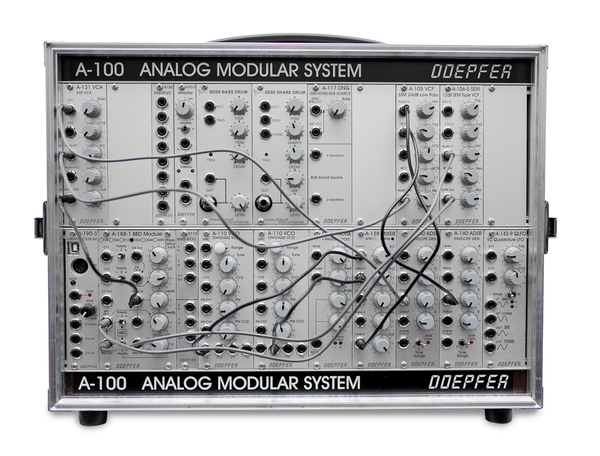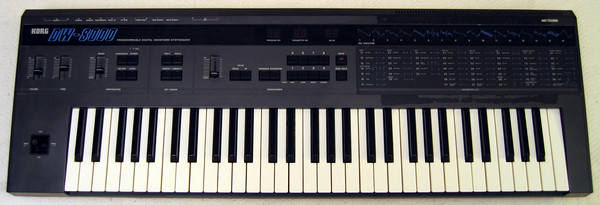S2.09 Kurt Uenala

Kurt Uenala: Musicmaker
“Kurt Uenala may not be a familiar name for many music fans, but chances are you've heard his work. The Swiss-born New Yorker is the kind of prodigious musician you'd call a "lifer": no matter where he is or what he's doing, music is the focus. He first made his name in 2003, debuting as Kap10Kurt on the essential compilation The Sound Of Young New York. His song "Die Sleeping" was an early classic of dreamy, club-ready synth pop, and it caught the attention of fans and artists around the world. It eventually landed him a gig recording with Depeche Mode singer Dave Gahan, not to mention a long list of major acts such as Moby and The Kills.”

null + void music
The debut Album "Cryosleep" featuring Dave Gahan, Black Rebel Motorcycle Club, Shannon Funshess and The Big Pink

Eurorack Doepfer A-100
In 1996, Doepfer Musikelektronik released the first Eurorack-format modular synthesizer system, the Doepfer A-100, followed by successive new series of compatible modules in 1997 and 1998. In the UK, Analogue Systems had been independently developing a very similar format, with small technical differences such as the power connectors. Analogue Systems would later change their products to offer Eurorack compatibility.

Novation Bass Station Rack (1994)
BassStation Rack (1994) included dual ADSR envelope shapers, 12/24db per octave filter, oscillator sync, and LFO, DCOs and built-in MIDI/Control Voltage (CV) converter. Users include William Orbit, Biosphere, Massive Attack, Orbital, Apollo 440, Nine Inch Nails, Radiohead, Jimi Tenor, Laurent Garnier, ATB, Sneaker Pimps, Out of Logic and Underworld.

Electronic Music Studios (EMS) Synthi A
The Synthi A and Synthi AKS models are virtually the same electronic instrument as the EMS VCS3, except that the Synthi models are housed in a thin plastic briefcase for easy portability. The Synthi A was also commonly known as the "Portabella". The AKS model (pictured below) adds a 256-step on-board monophonic digital sequencer and a 30-note touchplate keyboard (activated by the 50 Hz-hum in our fingers).

ARP 2600
Developed by a design team headed by ARP namesake Allen R. Pearlman and engineer Dennis Colin, the ARP 2600 was introduced in 1971 as the successor to ARP's first instrument, the ARP 2500, at a retail price of US$2600.
Unlike other modular systems of the time, which required modules to be purchased individually and wired by the user, the 2600 was semi-modular with a fixed selection of basic synthesizer components internally pre-wired, with clear text labels and front panel screen printed graphics indicating the function of different sections of controls, and the signal flow between them. The 2600 was thus ideal for musicians new to synthesis, due to its ability to be operated either with or without patch cords. On its initial release it was heavily marketed to high schools and universities.

MiniMoog
The Minimoog is an analog synthesizer first manufactured by Moog Music between 1970 and 1981. Designed as a more affordable, portable version of the modular Moog synthesizer, it was the first synthesizer sold in retail stores. It was first popular with progressive rock and jazz musicians and found wide use in disco, pop, rock and electronic music.
Production of the Minimoog stopped in the early 1980s after the sale of Moog Music. In 2002, founder Robert Moog regained the rights to the Moog brand, bought the company, and released an updated version of the Minimoog, the Minimoog Voyager. In 2016 and in 2022, Moog Music released another new version of the original Minimoog.

Korg DW-8000
The Korg DW-8000 synthesizer is an eight-voice polyphonic hybrid digital-analog synthesizer 61-note keyboard instrument released in 1985. By the time of its launch, Korg had already begun a common trend in 1980s synthesizer design: using numerical codes to access or change parameters (synth "voice", tone, etc) with its predecessor - the Korg Poly-61, which was widely regarded as the company's first "knobless" synthesizer. This was a move away from the heavily laden, complex control panels of earlier designs.
A more unusual feature of the instrument for the time was the use of single-cycle digital waveforms as the basic building block of sound synthesis, and the inclusion of a digital delay effect. This delay effect was a significant factor in the relative success of the DW-8000 compared to the cheaper DW-6000 released earlier the same year.

Prophet 5
The Prophet-5 is an analog synthesizer manufactured by the American company Sequential. It was designed by Dave Smith and John Bowen in 1977, who used microprocessors, then a new technology, to create the first polyphonic synthesizer with fully programmable memory. This allowed users to store sounds and recall them instantly rather than having to reprogram them manually; whereas synthesizers had once created unpredictable sounds, the Prophet-5 moved synthesizers to producing "a standard package of familiar sounds".
Between 1978 and 1984, about 6,000 units were produced across three revisions. In 1981, Sequential released a 10-voice, double-keyboard version, the Prophet-10. Sequential introduced new versions in 2020, and it has been emulated in software synthesizers and hardware. The Prophet-5 has been widely used in popular music and film soundtracks.
This is Lionel's first and favorite synth.

Jupiter 6
Although introduced as a less expensive ($2,500-$3,000 market price) alternative to the Roland Jupiter-8, its features include some capabilities not present in the JP-8, which makes the JP-6 a successor. The Jupiter-6 is widely considered a workhorse among polyphonic analog synthesizers, capable of producing a wide variety of sounds, such as ambient drones, pads, lead synthesizer lines, unison basses and techy blips and buzzes. It is renowned for its reliability and ease, but with sophisticated programmability.

Native Instruments Maschine
The included MASCHINE software comes loaded with an 8 GB sound library, created by renowned sound designers and artists. 8627 samples, 445 full drum kits, 388 multi-sampled instruments, 403 sliced loops, 1200 patterns, and 38 projects, plus five outstanding drum synths. A sonic palette as vast as your imagination.

Depeche Mode Austin City Limits 2013 Full Concert.
Welcome to my world.
This may or may not be the show Lionel saw. 2013.

Arrival (soundtrack)
Jóhann Jóhannsson was involved in pre-production for Arrival, and took early influence for the score from the film's script, concept art and initial discussions with director Denis Villeneuve about its mood and themes.

Love What’s Gone
The video I remember is no longer on youtube - Kurt did most of the production on this song.

Mazzy Star
Mazzy Star is an American alternative rock band formed in 1988 in Santa Monica, California, from remnants of the group Opal. Founding member David Roback's friend Hope Sandoval became the group's vocalist when Kendra Smith left Opal.
Mazzy Star is best known for the song "Fade into You", which brought the band some success in the mid-1990s and was the group's biggest mainstream hit, earning extensive exposure on MTV, VH1, and radio airplay. Roback and Sandoval were the creative center of the band, with Sandoval as lyricist and Roback as composer of the majority of the band's material until his death in Los Angeles on February 24, 2020, from metastatic cancer.
The band's most recent studio album, Seasons of Your Day, was released in 2013, followed by the EP Still in 2018.
photo by Paul Hudson from United Kingdom

Hello Mary
Hello Mary is a three-piece rock band from NYC comprised of guitarist/vocalist Helena Straight, drummer/vocalist Stella Wave and bassist Mikaela Oppenheimer. Melding together elements of indie rock, grunge and shoegaze, Hello Mary delivers lovely vocal harmonies layered over crunchy guitar parts, melodic bass lines, and driving drums that pay homage to the alt. rock scene of the 90's.
https://www.rollingstone.com/music/music-features/hello-mary-new-york-band-1234607414/

John Gorka
From New Jersey, John Gorka is a world-renowned singer-songwriter who got his start at a neighborhood coffeehouse in eastern Pennsylvania. Though small, Godfrey Daniels was and is one of the oldest and most venerable music institutions and has long been a hangout for music lovers and aspiring musicians. In the late 1970’s, John was was one of these aspiring musicians. Although his academic coursework at Moravian College lay in Philosophy and History, music began to offer paramount enticements. Soon he found himself living in the club’s basement and acting as resident MC and sound man.

epsy logidy pedal
EPSi is a solid 4" x 4" stompbox with minimal controls: just a terse, three-character LED, a data knob, an enter button, and a bypass footswitch. To select a new sound, simply scroll to the desired IR number and press enter. Same with altering the reverb time or adjusting the wet/dry mix: scroll and enter. This system works fine, just don’t count on changing tones mid-song, or even mid-set. But hey, even if you use only one IR per show (a nice juicy spring to soak the sound of a no-reverb amp, maybe?), you may find EPSi useful in performance.

Ólafur Arnalds: Broadchurch Soundtrack
This is the full album release of BAFTA Award and Televisual Bulldog Award winning soundtrack for the hit crime series, Broadchurch. Originally aired in the UK in ITV, Season 1 was a smash hit on BBC America and has since spawned a US remake (Gracepoint). FOCUS TRACK: Season two has a new closing song 'So Far' (featuring vocals of Arnor Dan) - which appears at the end of each episode. The album combines the best music of season 1 & 2. The US air dates start on February 4.






